As an Amazon Associate KitchenwareSets.com earns from qualifying purchases.
Discover 9 Modern Japanese Kitchen Ideas for Tranquil Spaces
Does the heart of your home feel more like the center of chaos? For many of us, the kitchen is a constant battleground of overflowing counters, mismatched utensils, and a general sense of disorganized stress. It’s the one room you can’t escape, yet it’s often the last place you feel at peace. This daily friction not only makes cooking a chore but also adds a layer of background anxiety to your life, a feeling that your own space is working against you.
You’ve likely tried countless organization hacks, bought bins and baskets, yet the clutter always seems to creep back in. It’s a frustrating cycle that leaves you wondering if a truly serene and functional kitchen is even possible. You see images of beautiful, minimalist spaces and crave that sense of calm, but the path from your current cluttered reality to that tranquil ideal feels impossibly long and complicated. It’s not just about being tidy; it’s about creating a space that nurtures you, a space where you can breathe.
A modern Japanese kitchen transforms a chaotic space into a tranquil one by emphasizing minimalism, natural materials, and smart organization. This design philosophy creates a functional yet serene heart of the home, proving that “less is more” is the ultimate luxury. It’s a system designed for peace and efficiency, and by integrating its core principles, you can craft a kitchen that is not only beautiful but also a genuine joy to live and cook in.
Feeling Overwhelmed by Kitchen Clutter? A Tranquil Japanese-Inspired Space Awaits
The solution to kitchen chaos often lies in a complete shift in philosophy from managing clutter to eliminating it at its source. A modern Japanese-inspired kitchen achieves this by focusing on intentionality, natural harmony, and flawless functionality. This approach isn’t just about a new look; it’s about creating a new relationship with your space—one built on calm, order, and beauty. Forget the stress of overflowing drawers and crowded countertops. Imagine a kitchen where every object has a purpose and a place, where clean lines and natural textures create a sanctuary for cooking and living. We’ve helped countless readers transform their chaotic kitchens into serene sanctuaries by applying these time-tested Japanese design principles, updated for modern life in 2025.
The Core Principles of Modern Japanese Kitchen Design
To truly create this serene space, it’s essential to first understand the foundational ideas that give modern Japanese kitchens their distinctive character. Understanding these core concepts is the first step any professional designer takes when creating an authentic Japandi or modern Japanese space. They are the guiding principles that inform every choice, from the color of the walls to the style of the cabinetry.
The core principles of modern Japanese kitchen design are:
* Minimalism (Kanso): This is the practice of simplicity and the elimination of the non-essential. It means keeping surfaces clear, valuing empty space (known as ma), and ensuring that every item is not only beautiful but also highly functional. It’s about clarity and purpose.
* Natural Materials (Shizen): A deep reverence for nature is central to Japanese design. This translates to a heavy reliance on materials like wood (especially light woods like oak and darker accents like walnut), stone (granite, quartz), and bamboo. These elements bring warmth and an organic, grounding feeling into the home.
* Neutral Colors: The color palette is drawn directly from nature. It’s dominated by calming shades of white, cream, beige, sand, and earthy tones. These muted colors create a restful backdrop, often punctuated by a single, strong accent of black or charcoal gray for contrast and definition.
* Functionality: A Japanese kitchen is a workspace designed for ultimate efficiency and ergonomic flow. Every layout consideration is made to minimize movement and maximize ease of use. This is where clever, hidden storage and modular units become critical components of the design.
9 Modern Japanese Kitchen Ideas for a Serene & Functional Space
Ready to transform your kitchen from a zone of stress into a sanctuary of calm? The beauty of Japanese design is that you don’t need a complete overhaul to start feeling its benefits. Incorporating a few key elements can make a dramatic impact. Each of these nine ideas is curated from successful design projects and adapted to be achievable for a home DIYer, ensuring a beautiful result based on proven concepts. Whether you’re planning a full remodel or just looking for a weekend refresh, these actionable tips will guide you in creating a space that is both visually stunning and deeply peaceful.
1. Embrace Natural Wood Elements
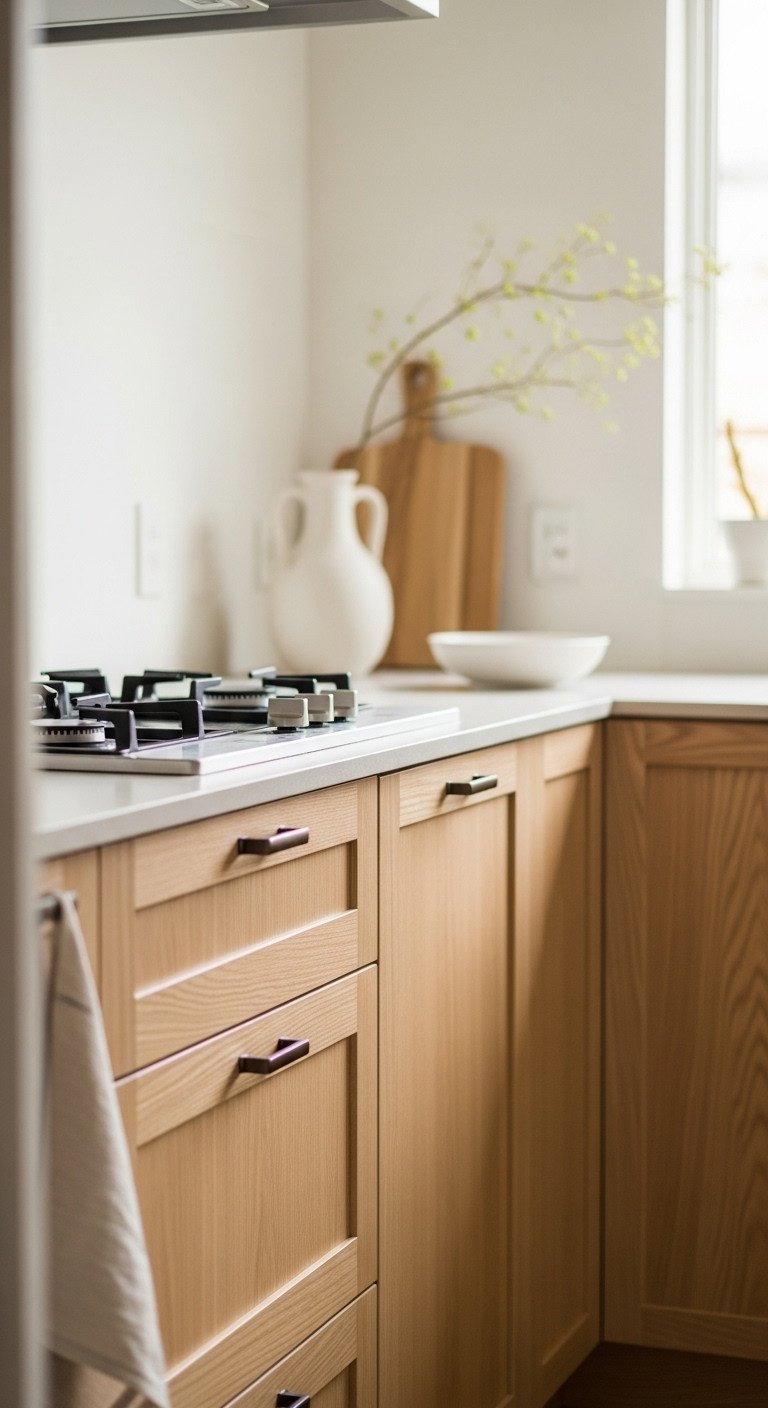
Save this idea to your ‘Japandi Kitchen Inspiration’ board!
The most crucial step in achieving a modern Japanese aesthetic is to introduce the warmth and texture of natural wood. Wood is the cornerstone of this design style, instantly connecting the kitchen to the natural world and providing a sense of grounding and tranquility. Light woods like oak, maple, and birch are especially popular in the blended Japandi style, as they create a bright and airy feel.
- Materials Needed: Light wood veneer or contact paper, measuring tape, craft knife, squeegee tool, cabinet cleaner/de-greaser.
- Step-by-Step Directions:
- Begin by thoroughly cleaning your existing cabinet doors to remove any grease or grime. A good de-greaser is essential for proper adhesion. Let them dry completely.
- Carefully measure one cabinet door. Transfer the measurements to the back of your wood-look contact paper, adding a one-inch margin on all sides to allow for wrapping the edges.
- Cut the contact paper using a sharp craft knife for clean lines. Peel back a small corner of the backing and align it with the corner of your cabinet door.
- Slowly peel the backing away while using a squeegee to smooth the contact paper onto the surface, pushing out any air bubbles as you go. Work from the center outwards. For a more permanent and authentic solution, a high-quality light oak wood veneer provides an unparalleled texture and finish.
- Wrap the excess paper around the edges for a seamless, professional look and trim any remaining excess with a sharp craft knife.
Pro-Tip: Always run the wood grain vertically on cabinet doors. This simple trick draws the eye upward, making your kitchen feel taller and more spacious, enhancing the open feeling that is key to Japanese design.
2. Opt for a Muted, Earthy Color Palette
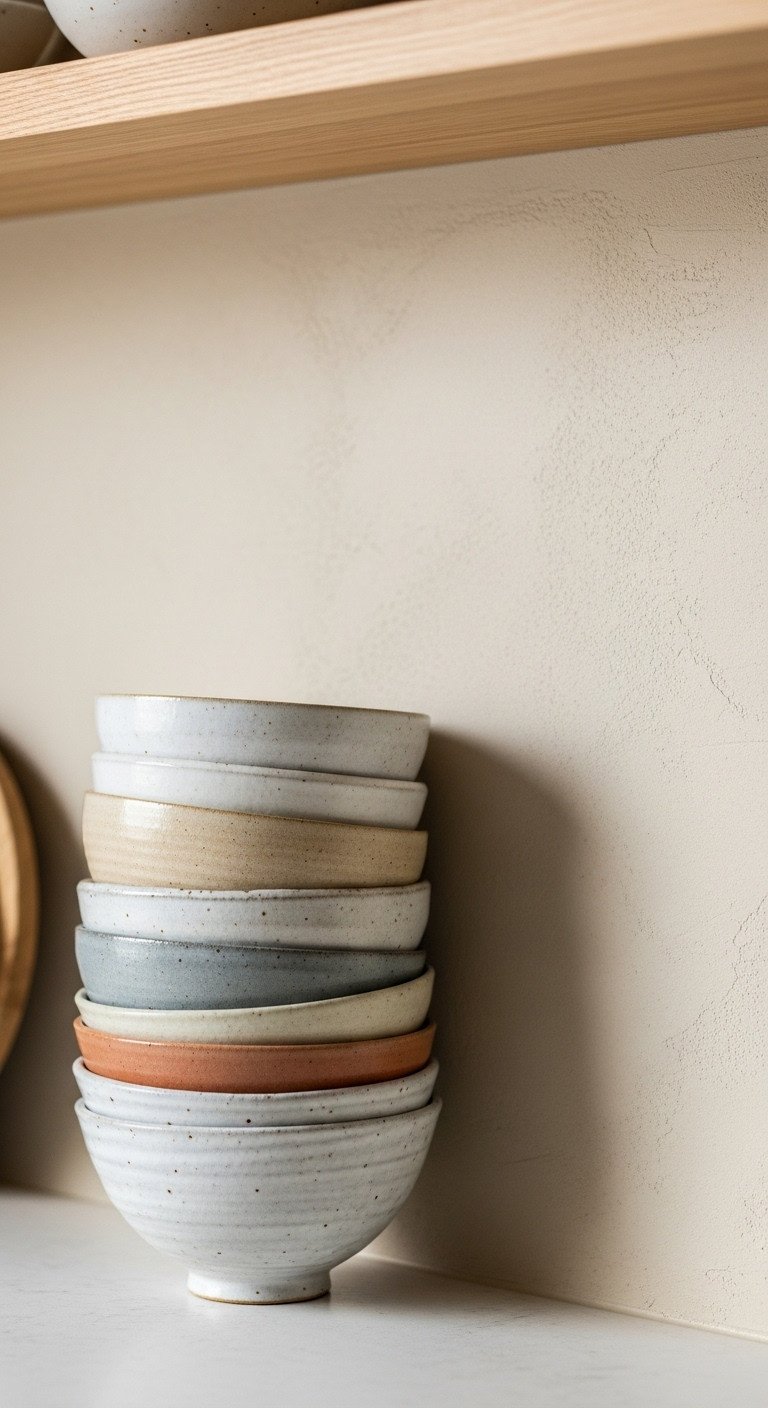
Pin this color palette for your serene kitchen project!
The feeling of tranquility in a Japanese kitchen comes directly from its color scheme, which is borrowed from the natural world. Think of the colors of stone, sand, wood, and clay. These muted, warm, and earthy tones create a soothing environment that feels both sophisticated and incredibly restful. Avoid stark, cold whites and instead lean into shades of cream, ivory, beige, taupe, and greige.
- Materials Needed: High-quality interior paint in a neutral shade (e.g., beige, greige, or warm white), paint rollers, brushes, painter’s tape, drop cloths.
- Step-by-Step Directions:
- Select two to three core neutral colors to build your palette. A popular and effective combination is a warm white for the main walls, a soft beige or greige for the cabinets, and a deeper taupe or charcoal for a subtle accent.
- Prepare your kitchen by thoroughly cleaning the walls and taping off all trim, countertops, and appliances. Lay down drop cloths to protect your floors and counters from drips.
- Apply your main wall color first using a roller for the large areas and a brush for cutting in the edges. For a truly authentic Wabi-Sabi feel that celebrates imperfection, consider using a limewash paint. This type of paint provides a soft, suede-like texture full of natural, subtle variations.
- Once the walls are completely dry (check the can for cure times), you can begin painting your cabinets with your chosen secondary color.
- Use your third, slightly darker accent color sparingly. It’s meant to add depth and prevent the space from feeling flat. Consider it for a small island, a set of open shelves, or the window trim.
Lesson Learned: Always get paint samples and test them directly on your walls. The same color can look dramatically different depending on the amount and direction of natural light in your specific kitchen throughout the day. Live with the samples for a day or two before committing.
3. Integrate Minimalist, Handleless Cabinetry

Save this sleek look to your ‘Minimalist Home’ board!
A key to the uncluttered look of a Japanese kitchen is removing visual noise, and cabinet hardware is a primary culprit. Flat-panel, handleless cabinets create a seamless, monolithic look that is both calming and highly modern. This streamlined appearance allows the texture of the wood or the color of the cabinets to become the main feature.
- Materials Needed: Push-to-open cabinet hardware kit, drill with appropriate bit, screwdriver, pencil, measuring tape, wood filler, sandpaper.
- Step-by-Step Directions:
- Start by removing all existing handles or knobs from your cabinet doors and drawers. Fill the resulting holes with wood filler, let it dry, sand it perfectly smooth, and then touch up the paint or finish.
- For the ultimate minimalist look, your best solution is a push-to-open hardware system. These clever mechanical or magnetic devices are installed on the inside of the cabinet frame, making them completely invisible from the outside.
- Open a cabinet door and choose a spot on the inside frame, typically opposite the hinges, for the mechanism. Use a pencil to mark the screw holes for the hardware.
- Drill small pilot holes to prevent the wood from splitting, then screw the push-to-open latch securely into place on the cabinet frame.
- Attach the corresponding magnetic plate or striker to the inside of the cabinet door, ensuring it aligns perfectly with the latch when the door is closed. This alignment is critical.
- Test the mechanism. The door should click shut and then spring open with a gentle push, eliminating the need for any external handle.
Pro-Tip: For heavy pantry doors or deep drawers filled with pots and dishes, make sure you invest in a heavy-duty push-to-open system. These have stronger springs and magnets to ensure they work reliably and won’t fail under the weight.
4. Maximize Natural Light and Openness
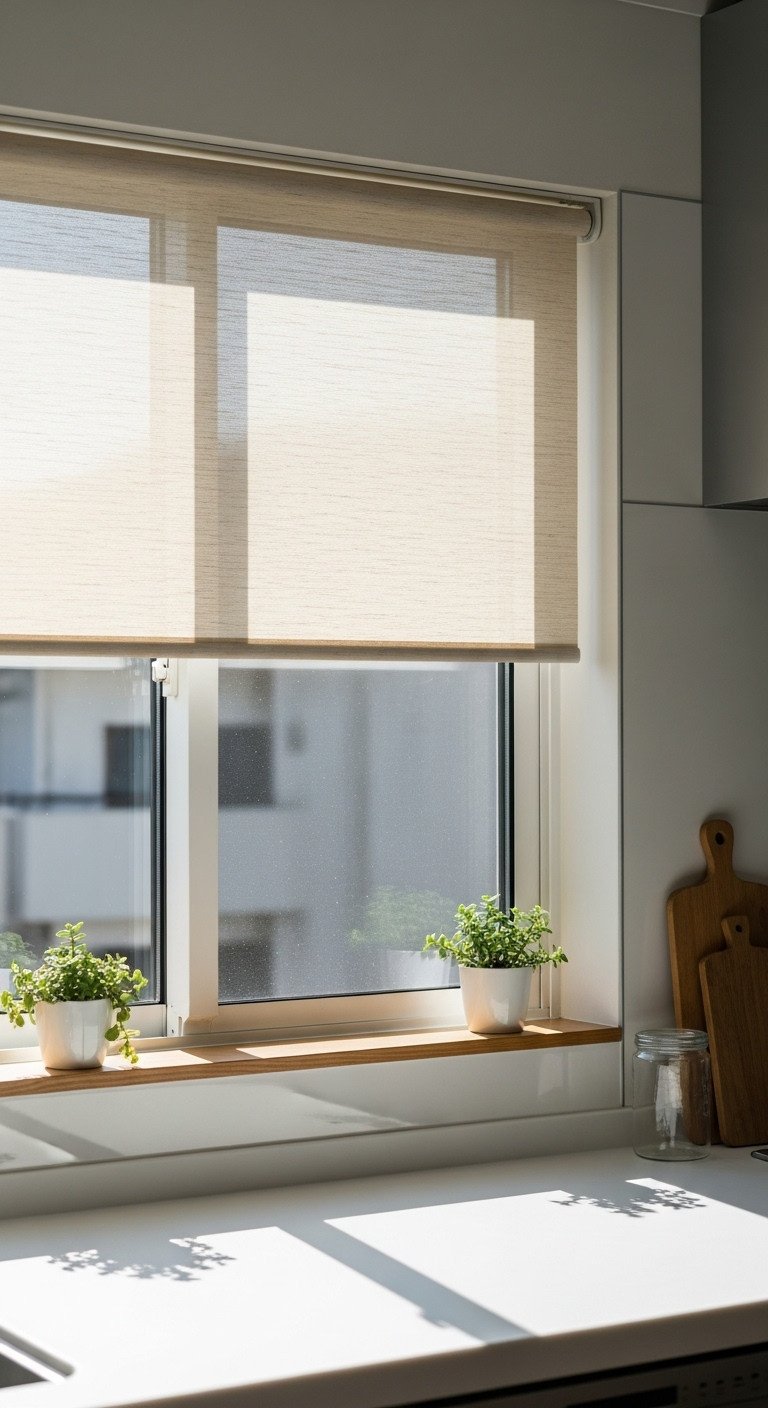
Add this bright and airy idea to your ‘Dream Kitchen’ board!
Japanese design seeks to blur the lines between indoors and outdoors, and the best way to do this is by flooding the space with as much natural light as possible. Light makes a space feel larger, cleaner, and more energetic. This means choosing window treatments that diffuse light rather than block it, keeping windows unobstructed.
- Materials Needed: Bamboo roll-up blinds or sheer linen curtains, mounting hardware (usually included), drill, measuring tape, pencil.
- Step-by-Step Directions:
- Immediately remove any heavy, dark, or fussy curtains or blinds from your kitchen windows. The goal is an unobstructed view and maximum light. Clean the windows and frames thoroughly to let the sunshine in.
- To maintain privacy while still maximizing light, opt for window treatments that soften and diffuse the light. A bamboo roll-up blind is a classic choice that adds beautiful natural texture and casts a warm, inviting glow. Sheer linen or cotton panels also work beautifully.
- For a clean, inside-mount look, measure the interior width of your window frame. Purchase a blind that is about a quarter to a half-inch smaller than this measurement.
- Follow the manufacturer’s instructions to install the mounting brackets inside the top of the window frame. Use a level to ensure they are straight.
- Simply click the headrail of the blind into the brackets until it’s secure. Test the roll-up mechanism to ensure it operates smoothly.
Pro-Tip: If you have a small or dark kitchen, hang a simple, large, frameless mirror on a wall that is opposite the main window. It will act like a second window, bouncing natural light all around the room and making the space feel significantly larger and brighter.
5. Choose Simple, Organic-Shaped Decor
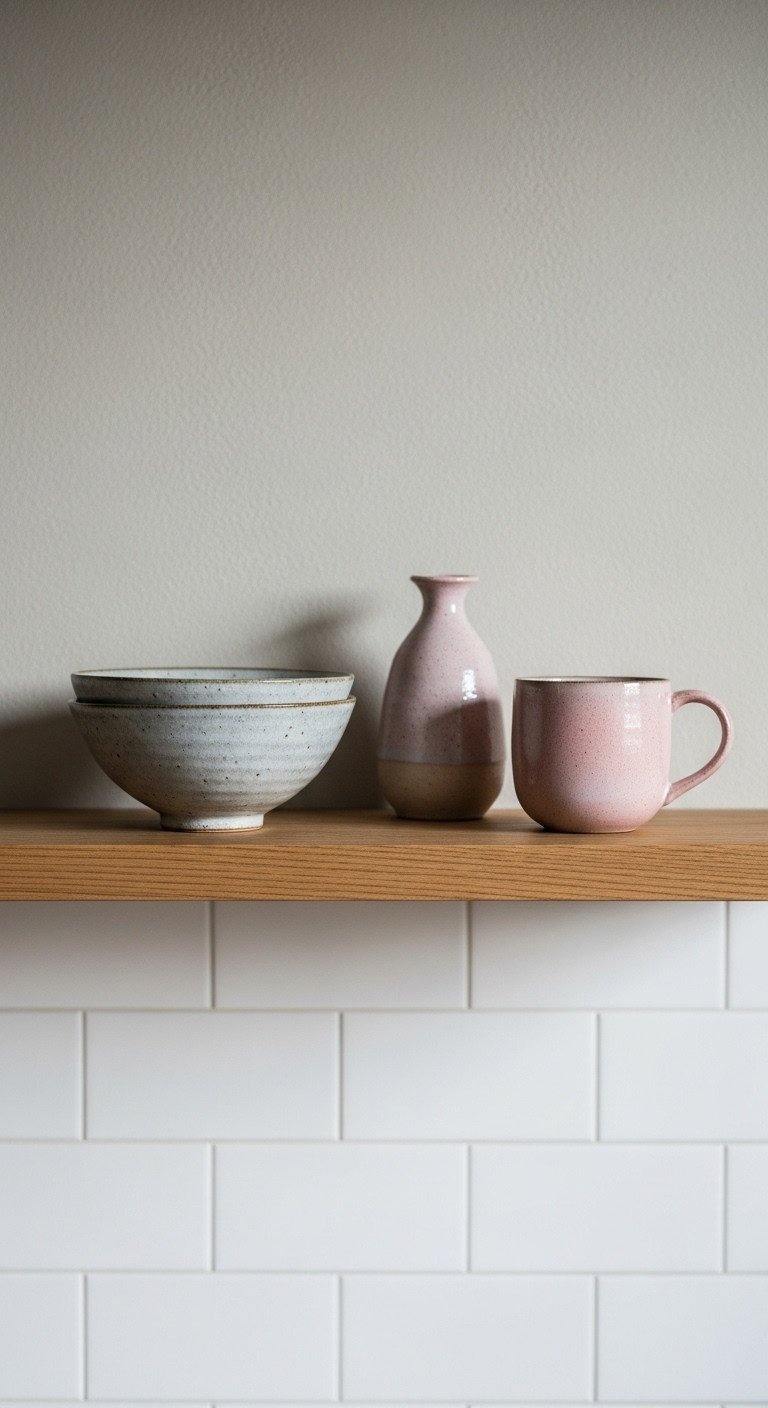
Love this look? Pin it to your ‘Home Decor’ board!
In a minimalist space, the few decorative items you choose have a huge impact. The key is to select decor that is simple, functional, and celebrates natural, organic forms. This aligns with the Wabi-Sabi philosophy, which finds beauty in imperfection. Look for pieces that have a handmade quality, with subtle irregularities that give them soul and character.
- Materials Needed: A curated selection of 3-5 decor items, a floating shelf or clear counter space.
- Step-by-Step Directions:
- The guiding principle for Japanese decor is intentionality. Instead of filling a shelf with many small, generic items, choose a few larger, more impactful pieces that you truly love.
- Search for items made from natural materials with organic shapes and textures. Think handmade ceramic bowls, a beautifully carved wooden tray, a simple glass vase for a single branch, or linen tea towels.
- Create a small, thoughtful arrangement, or vignette, on an open shelf or in a clear corner of your countertop. An easy and visually pleasing formula is the classic “rule of three.”
- Group three related items of varying heights and textures. For example, you could pair a small Wabi-Sabi style ceramic vase, a medium-sized stoneware bowl for fruit, and a taller wooden utensil holder.
- Most importantly, ensure there is plenty of negative space around your arrangement. The empty space is just as critical as the objects themselves, as it allows each piece to be seen and appreciated.
Lesson Learned: Resist the powerful urge to fill every empty surface. I learned that a single, beautiful, and meaningful object placed on an otherwise empty counter makes a much stronger and more serene statement than a dozen mediocre ones.
6. Create Contrast with Matte Black Accents
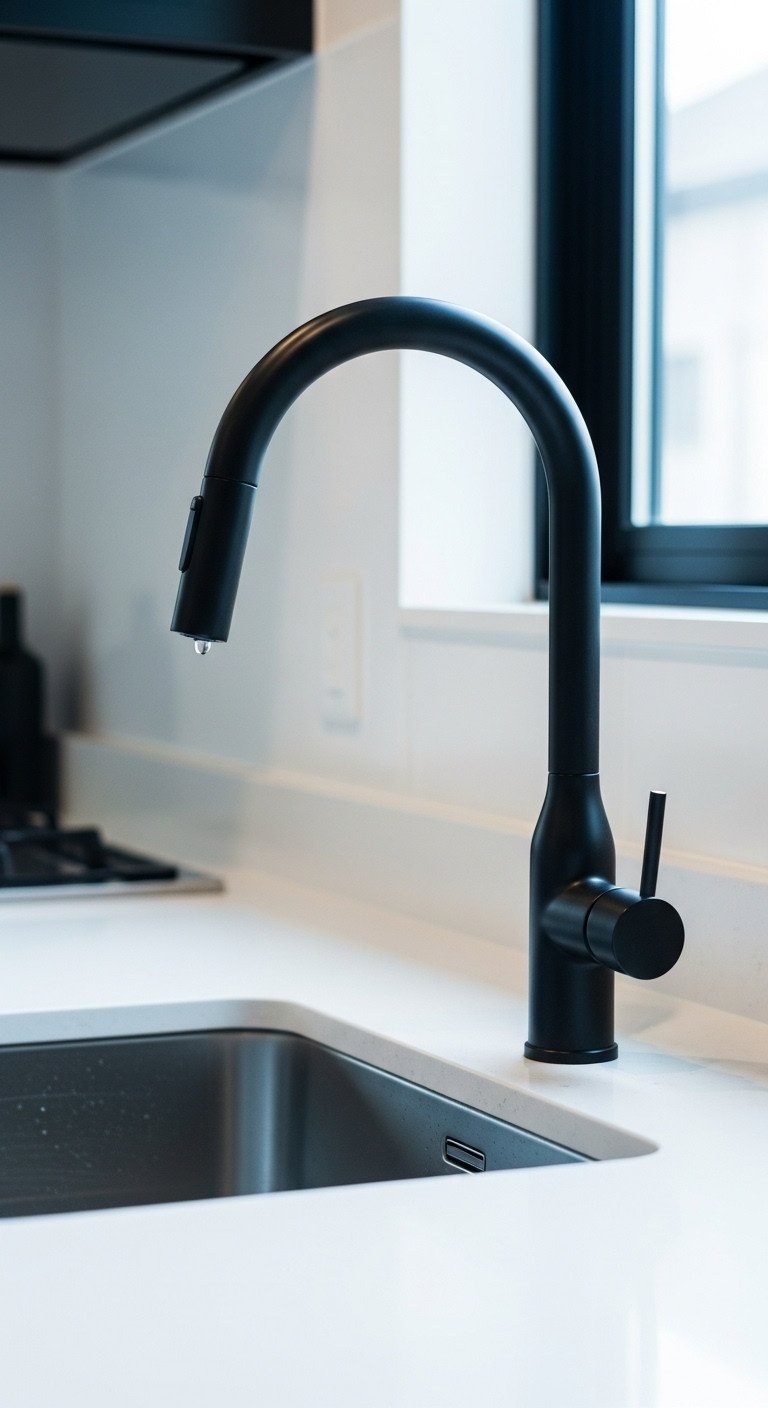
Save this bold idea to your ‘Kitchen Remodel’ board!
While the overall palette is soft and neutral, a modern Japanese kitchen needs a touch of black to create contrast and add a sophisticated, grounding element. Matte black is the perfect choice, as its non-reflective surface absorbs light and provides a quiet strength. Used sparingly, it highlights the shapes and textures around it.
- Materials Needed: Matte black spray paint for metal, painter’s tape, screwdriver, degreaser, new matte black faucet (optional).
- Step-by-Step Directions:
- The easiest and most impactful way to introduce a black accent is by updating your hardware. Start with your faucet, as it’s a natural focal point.
- For a very budget-friendly update, you can spray paint your existing faucet. Remove it, clean it thoroughly with a strong degreaser, and tape off any parts you don’t want painted. Apply several very thin coats of a high-quality matte black spray paint specifically designed for metal, allowing it to dry completely between coats.
- For a more durable and high-impact change that will last for years, invest in a new matte black kitchen faucet. A sleek, gooseneck design is a perfect fit for this aesthetic and can serve as the primary focal point of the entire design.
- Install the new or repainted faucet according to the manufacturer’s instructions.
- Consider adding one or two other small black elements to tie the look together. This could be as simple as thin black frames on artwork, matte black cabinet pulls (if you aren’t going handleless), or a black metal pendant light.
Pro-Tip: When using black in a minimalist design, less is always more. The goal is to create punctuation and visual interest, not to darken the room. I recommend starting with just the faucet. Live with it for a week and see how it feels before you consider adding more.
7. Incorporate a Touch of Greenery
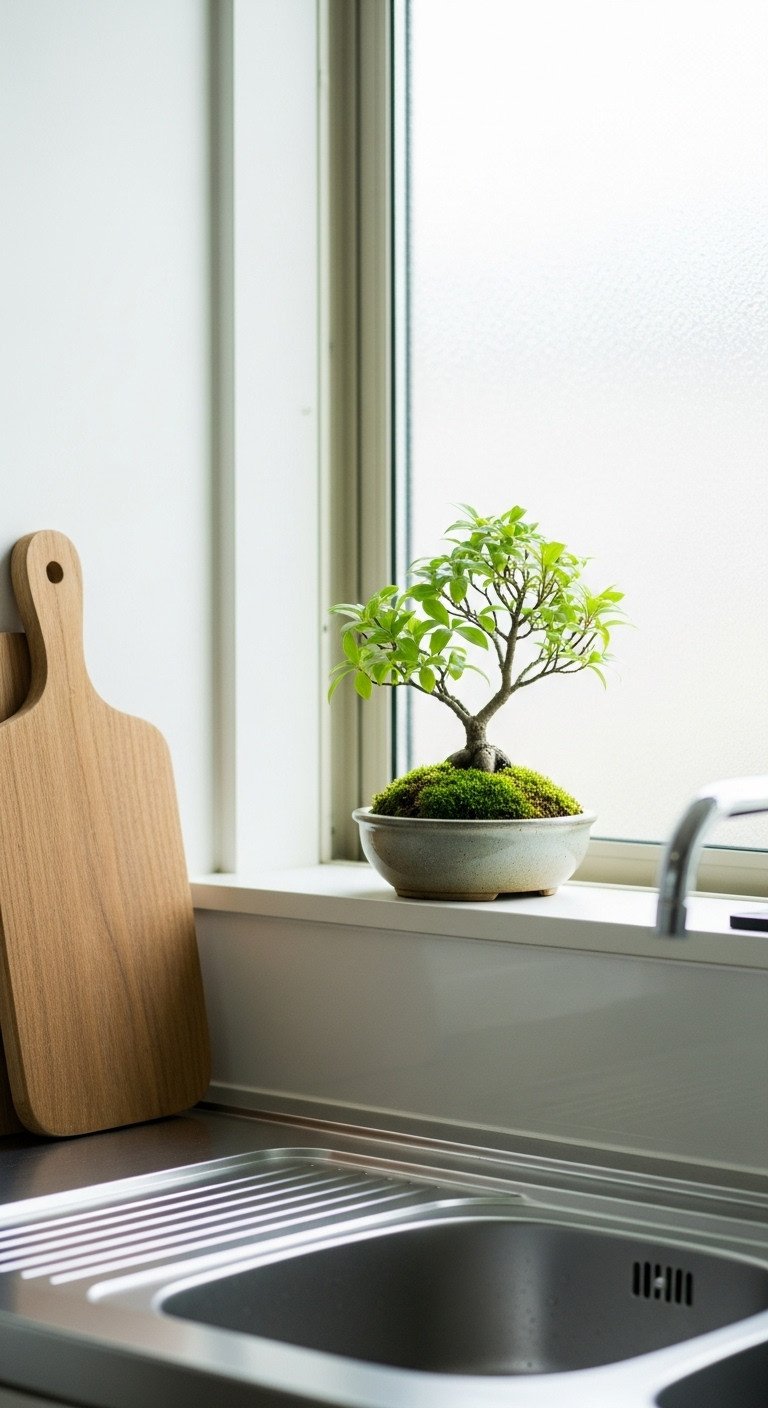
Bring some life to your kitchen! Pin this green idea.
No Japanese-inspired space is complete without a living element that brings life and a final touch of nature indoors. A single, well-chosen plant provides a splash of vibrant color and an organic form that contrasts beautifully with the clean lines of the kitchen. Choose plants with interesting shapes and structures.
- Materials Needed: A small plant, appropriate potting soil, a simple ceramic or stone pot with a drainage hole.
- Step-by-Step Directions:
- Choose a plant that reflects a minimalist and sculptural aesthetic. A small snake plant with its architectural leaves, a single stalk of lucky bamboo in a glass vase, or a delicate orchid are all excellent, low-maintenance choices.
- For a truly authentic and meditative touch, consider a beginner bonsai tree kit. These wonderful kits come with everything you need to grow and shape your own miniature tree, a practice that is deeply rooted in Japanese culture and the appreciation of nature.
- Select a simple, understated pot made from a natural material like ceramic, stone, or terracotta. Avoid bright colors or busy patterns. Critically, ensure it has a drainage hole at the bottom to prevent root rot.
- Pot your chosen plant using the appropriate soil mix (e.g., succulent mix for a snake plant, bonsai soil for a bonsai).
- Place your plant in a spot where it will receive the right amount of light. A windowsill is often perfect, as is a countertop near a window. Avoid placing it directly above a heat source like a toaster or stove, which can dry it out.
Lesson Learned: The biggest mistake I and many other beginners make is overwatering. It comes from a place of love, but it’s deadly for most houseplants! Always check if the top inch of soil is completely dry to the touch before watering your kitchen plant again.
8. Prioritize Hidden Storage Solutions
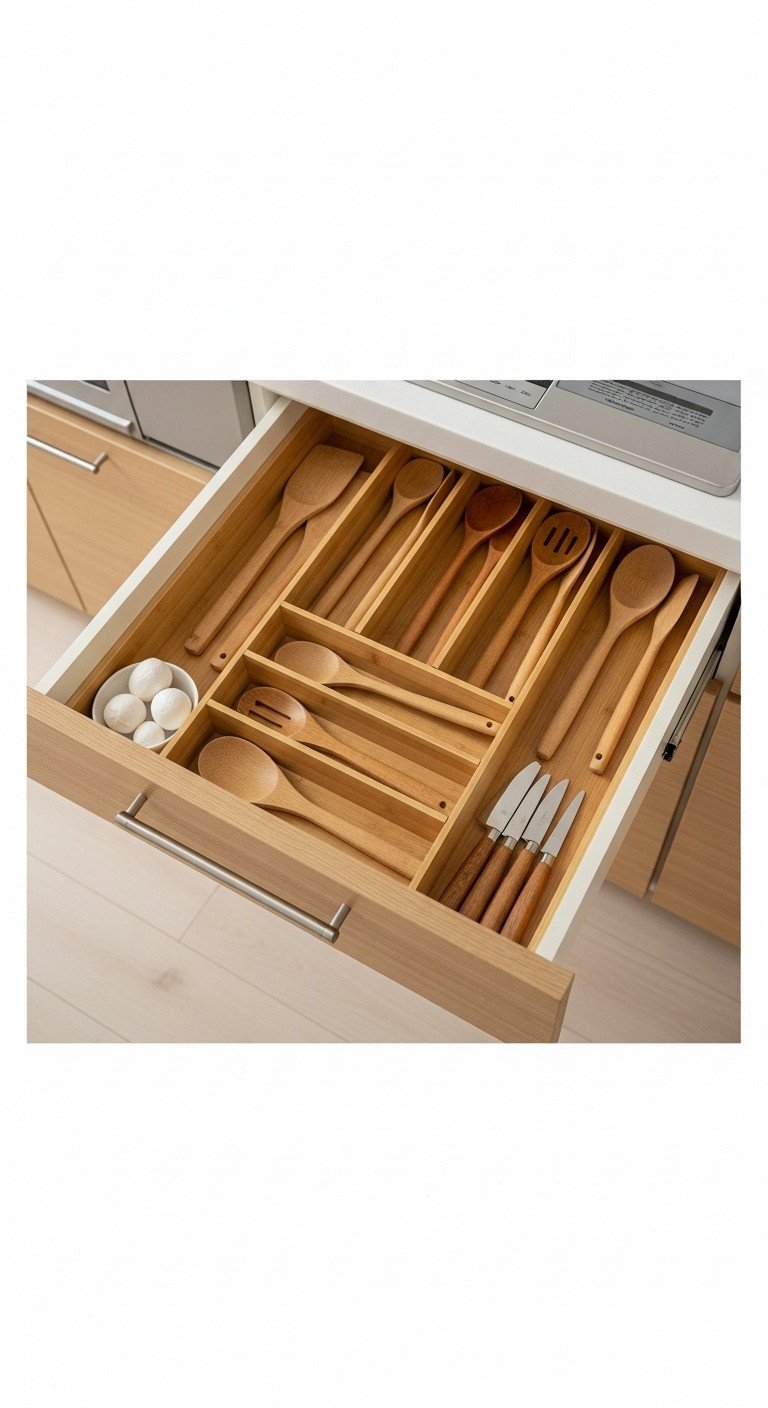
Get organized! Save this storage hack to your ‘Home Organization’ board.
The serene, clutter-free look of a Japanese kitchen is only possible with highly effective, invisible organization systems. The philosophy is simple: a home for everything, and everything in its home. This means maximizing the utility of every cabinet and drawer so that countertops can remain almost completely empty.
- Materials Needed: Expandable bamboo drawer dividers, measuring tape.
- Step-by-Step Directions:
- The ultimate goal of a Japanese kitchen is to have clear countertops. Begin by doing an audit of everything currently living on your counters. What could be stored away in a drawer or cabinet?
- Tackle your messy utensil drawer first. Empty it completely and give it a good wipe down.
- Measure the interior length or width of your drawer. This will determine the size of the dividers you need.
- Use expandable bamboo drawer dividers to create custom-sized compartments. These are fantastic because they are spring-loaded, fitting snugly into place without any tools or hardware required. The bamboo material also perfectly matches the natural aesthetic.
- Arrange the dividers to create specific, dedicated homes for your cooking utensils, cutlery, and miscellaneous gadgets.
- This is the most important step: return only the items you use regularly to the drawer, placing them in their new designated spots. Be honest with yourself and donate or discard the rest.
Pro-Tip: Apply this “a home for everything” principle to all of your cabinets. I found that installing simple pull-out shelves for pots and pans and using clear, uniform containers for pantry staples were game-changers for maintaining order behind closed doors.
9. Layer Soft, Diffused Lighting
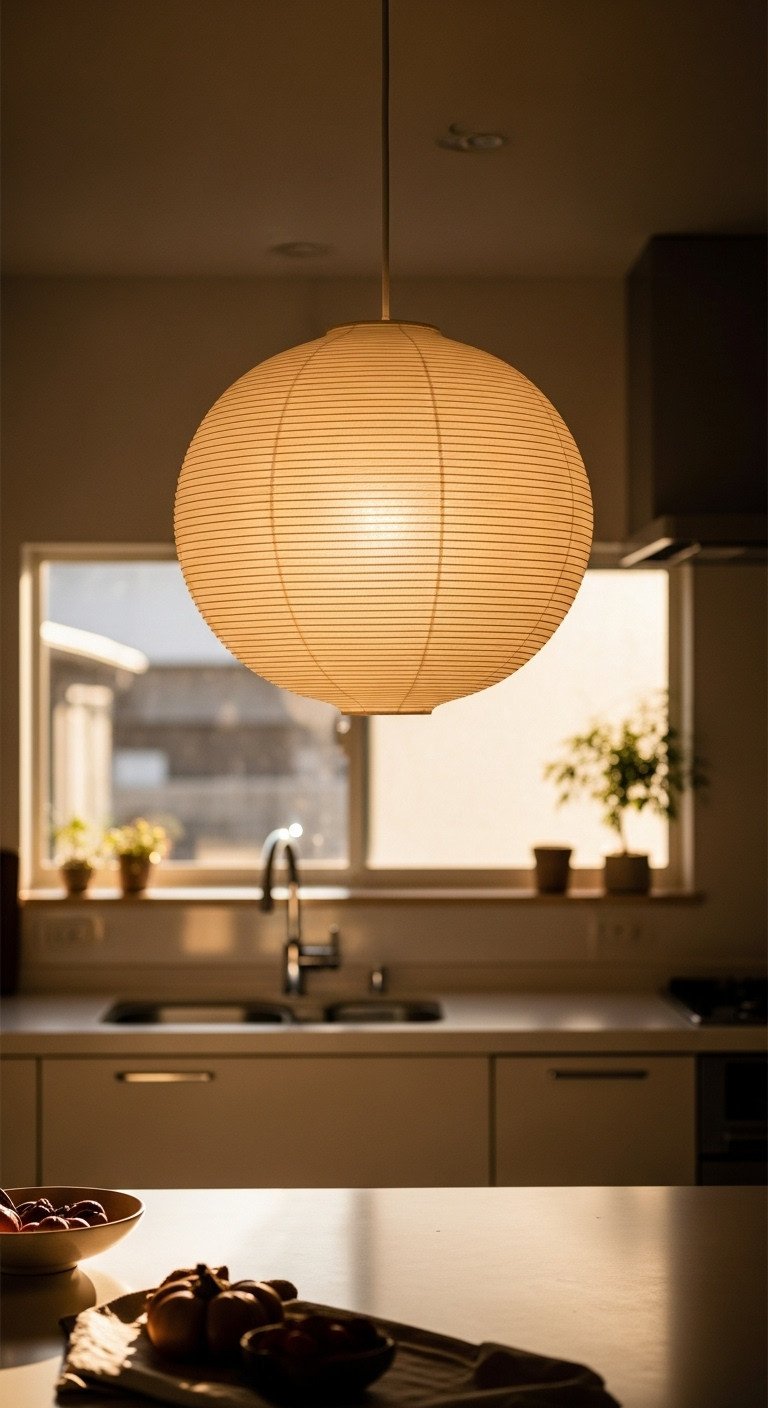
Pin this cozy lighting idea for a warm and inviting kitchen!
Lighting is everything when it comes to creating mood. To achieve a serene ambiance, you must avoid harsh, direct overhead lighting and instead layer multiple sources of soft, diffused light. The goal is to mimic the gentle, warm glow of traditional paper lanterns, creating a space that feels welcoming and calm.
- Materials Needed: Pendant light kit, paper or fabric lantern shade, warm white LED bulb, wire strippers, screwdriver. (Always consult a licensed electrician if you are not comfortable or experienced with electrical wiring).
- Step-by-Step Directions:
- The first rule is to get rid of any single, harsh, central ceiling light (often called a “boob light”). The goal is to create layers of light from different sources and heights.
- The centerpiece of your new lighting scheme should be a beautiful statement pendant light. A Japanese paper lantern pendant light, or one with a fabric or woven shade, is the perfect choice for providing a beautiful, soft, and diffused glow over a kitchen island or dining area.
- Begin by turning off the power to the kitchen at the circuit breaker. Double-check that it’s off. Carefully remove your old light fixture.
- Follow the instructions included with your new pendant light kit to wire it into the ceiling junction box, connecting the corresponding wires (black to black, white to white, and green/copper to ground).
- Attach the paper or fabric shade. Install a warm white (rated between 2700K-3000K) LED bulb. This color temperature is crucial for a cozy, non-sterile glow.
- Restore power and test your beautiful new light. For a complete solution, supplement this ambient light with under-cabinet LED strips for bright, functional task lighting directly on your countertops.
Pro-Tip: I cannot recommend this enough: install a dimmer switch for your main pendant light. This is a simple and inexpensive job for an electrician and it gives you complete control over the kitchen’s ambiance, allowing you to go from bright and functional for cooking to a soft, warm glow for relaxing or dining in the evening.
Key Takeaways: Your Quick Guide to a Modern Japanese Kitchen
Transforming your kitchen into a tranquil, Japanese-inspired space is an achievable goal built on a few core principles. To quickly recap, here are the most impactful takeaways to guide your project:
- Focus on Natural Materials: This is non-negotiable. Prioritize wood for cabinetry and shelving, stone or quartz for countertops, and bamboo for accents. These materials are the soul of the design, creating essential warmth and a connection to the outdoors.
- Embrace Minimalism: This is more than just decluttering; it’s a mindset. Keep countertops as clear as possible by ensuring every single item has a designated, hidden home. Remember the principle of ma—the value of empty space. Less is truly more.
- Use a Muted Color Palette: Create a foundation of calm by sticking to warm whites, beiges, greiges, and other earthy tones. Use matte black sparingly and intentionally as a sharp, sophisticated accent to add definition.
- Layer Soft Lighting: Ditch the single harsh overhead light. Combine a beautiful, diffused pendant light (like a paper lantern) for ambient glow with hidden under-cabinet lights for practical task lighting. Always choose warm white bulbs.
- Incorporate Greenery: A single, well-placed plant completes the look. A small bonsai, a structural snake plant, or a delicate orchid adds a vital touch of life and vibrant color, reinforcing the connection to nature.
People Also Ask About Modern Japanese Kitchens
What is the difference between Japanese and Japandi kitchen design?
A traditional Japanese kitchen design is purely minimalist, often utilizing darker woods and adhering strictly to ancient design principles like Kanso (simplicity) and Shibui (unobtrusive beauty). Japandi design, on the other hand, is a popular hybrid style that blends Japanese minimalism with the cozy, functional warmth of Scandinavian design. It often features lighter woods (like Scandinavian oak), more soft textiles, and a focus on “hygge” (coziness), all while maintaining the same clutter-free, nature-inspired ethos.
How can I apply Japanese design principles to a very small kitchen?
Japanese design is perfectly suited for small kitchens because its core tenets are efficiency and the elimination of clutter. Focus on maximizing vertical space with tall, streamlined cabinets and a few well-placed minimalist floating shelves. Use a very light, neutral color palette to make the space feel larger and more open. Prioritize multi-functional items and, most importantly, be ruthless about decluttering. Hidden storage solutions like expandable drawer dividers and pull-out organizers are absolutely essential for making a small space feel serene.
What are the best materials for a modern Japanese kitchen countertop?
The best countertop materials are natural or natural-looking ones that are durable and have a subtle texture. Light-colored quartz or granite are excellent choices as they offer the durability and organic texture of stone with minimal maintenance. For a warmer, more traditional feel, a high-quality butcher block countertop made from a light wood like oak or maple is a fantastic option that pairs beautifully with the wood cabinetry and neutral color schemes typical of the style.
Final Thoughts
Creating a modern Japanese kitchen is about so much more than following a trend; it’s about crafting a space that actively brings a sense of peace and order to your daily life. It’s a conscious choice to surround yourself with simplicity, to honor nature, and to be intentional with the objects you live with. By making these thoughtful changes, you can transform the heart of your home from a source of stress into a true sanctuary.
Which of these ideas are you most excited to try in your own space? Let us know in the comments below
Last update on 2025-10-15 at 13:40 / Affiliate links / Images from Amazon Product Advertising API
